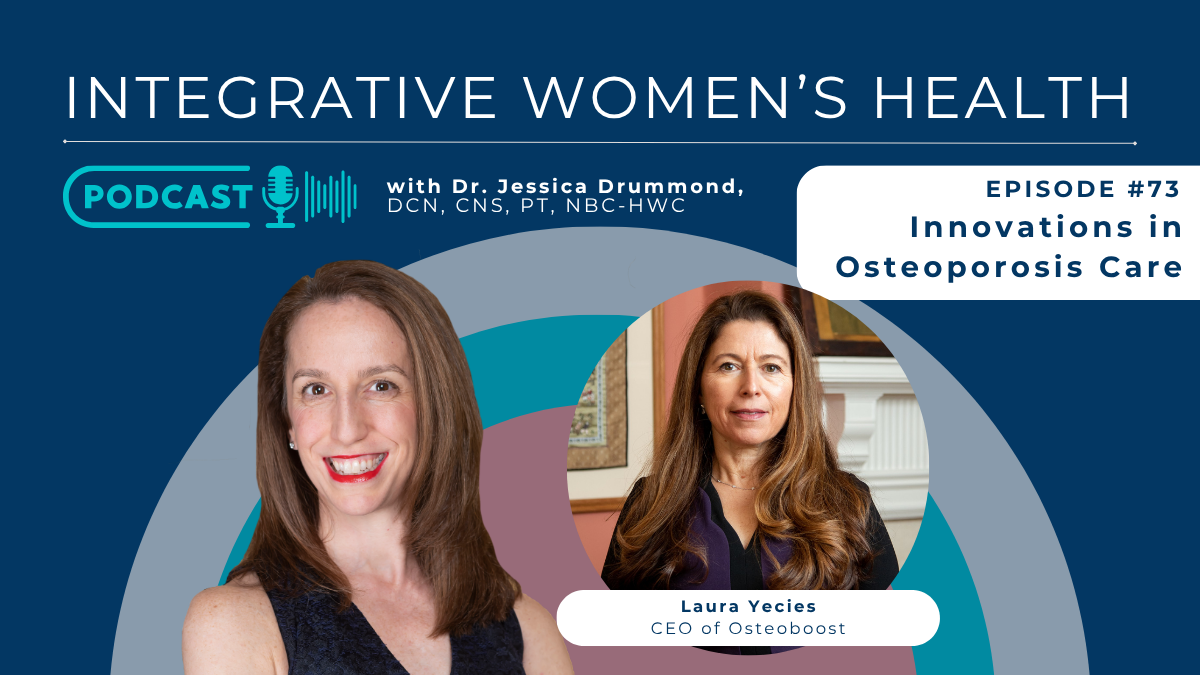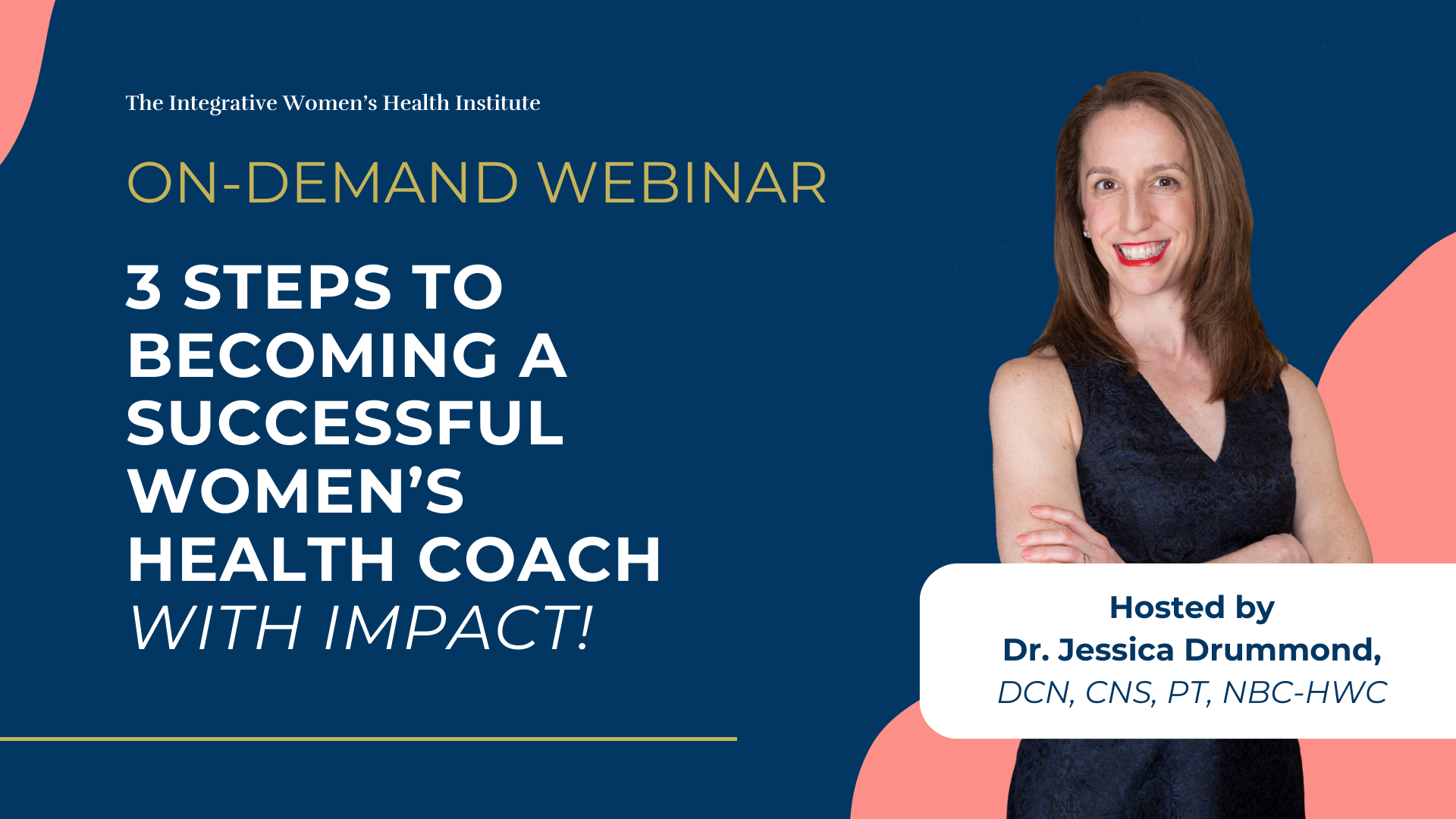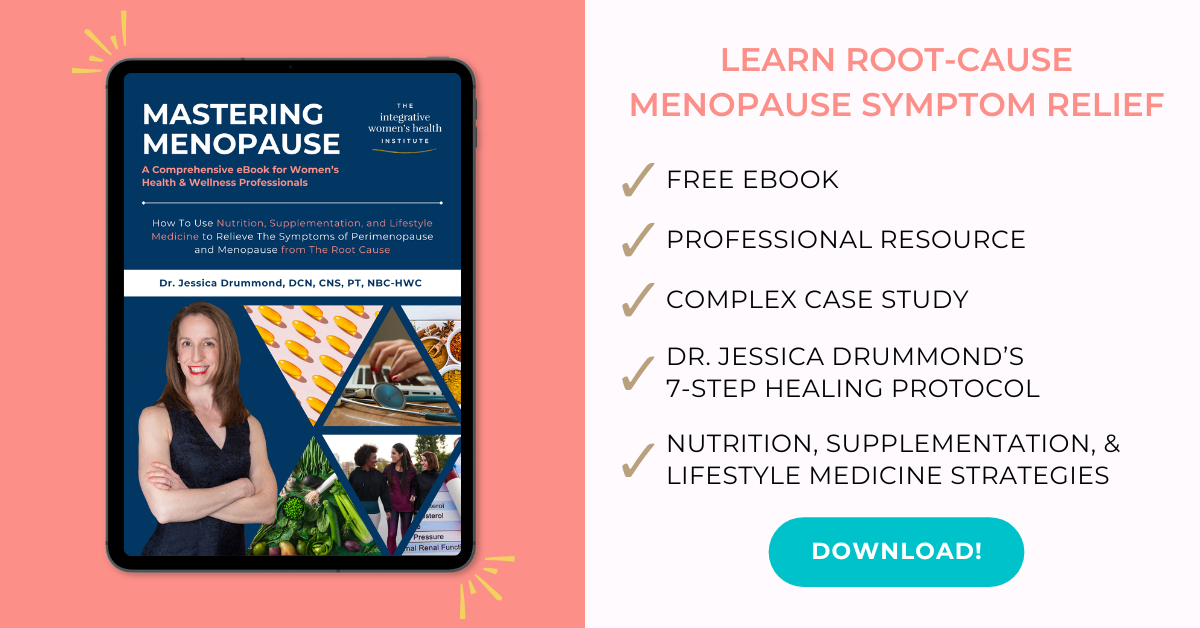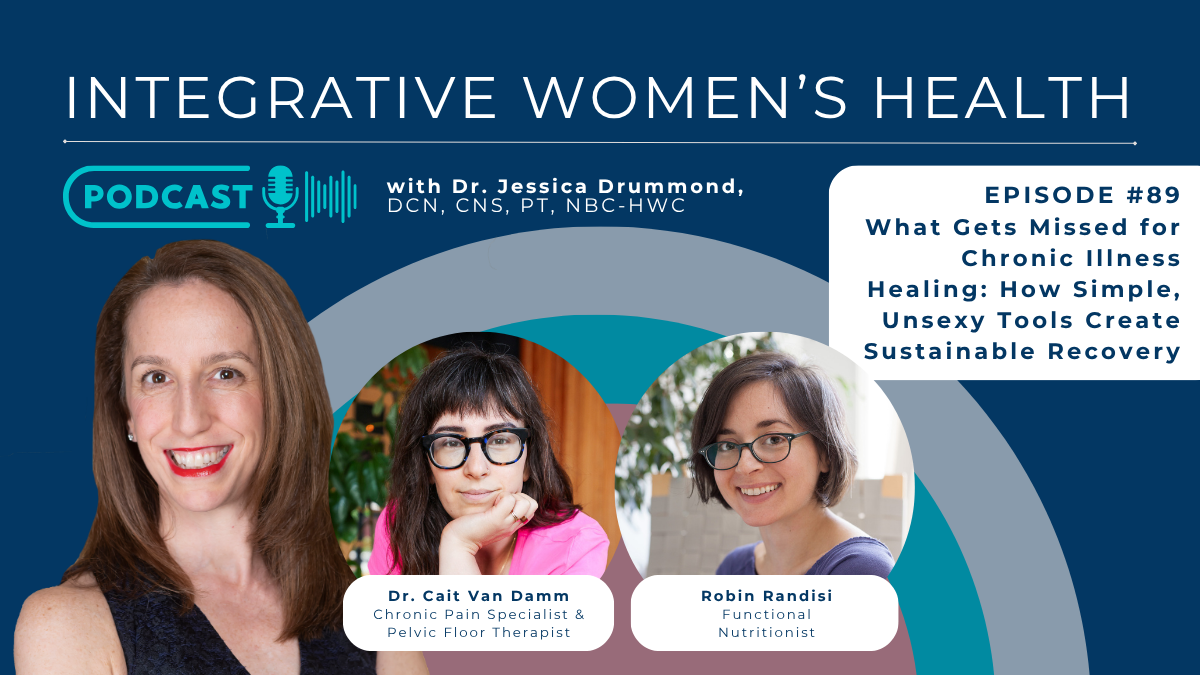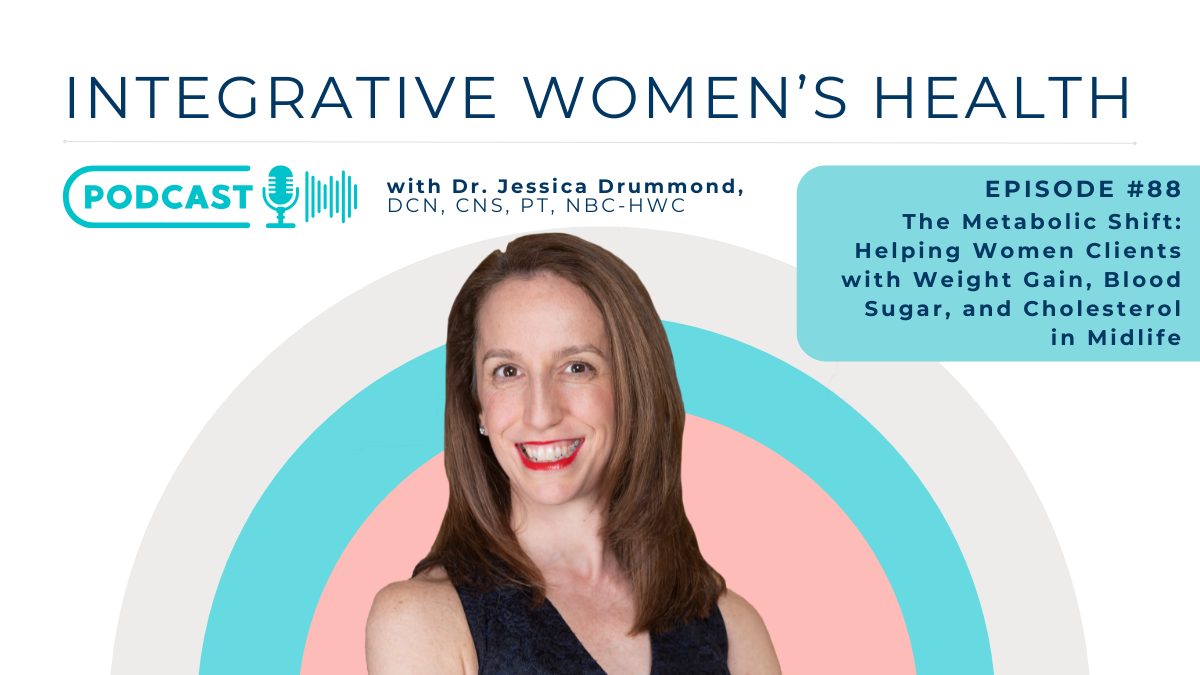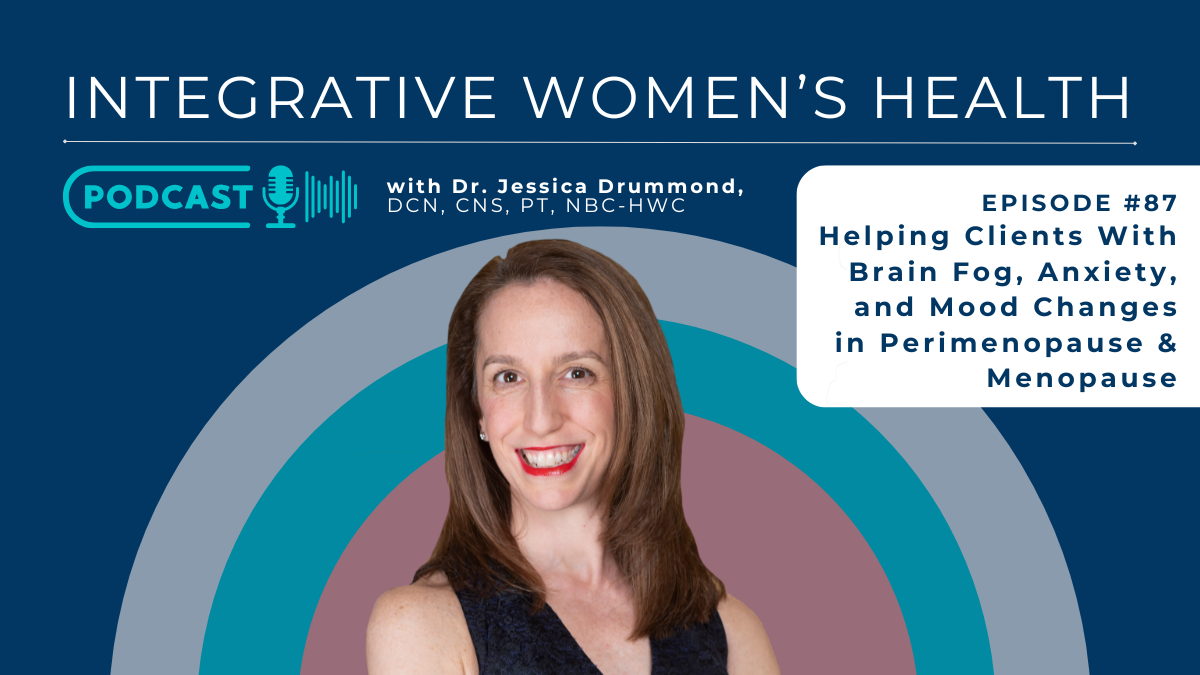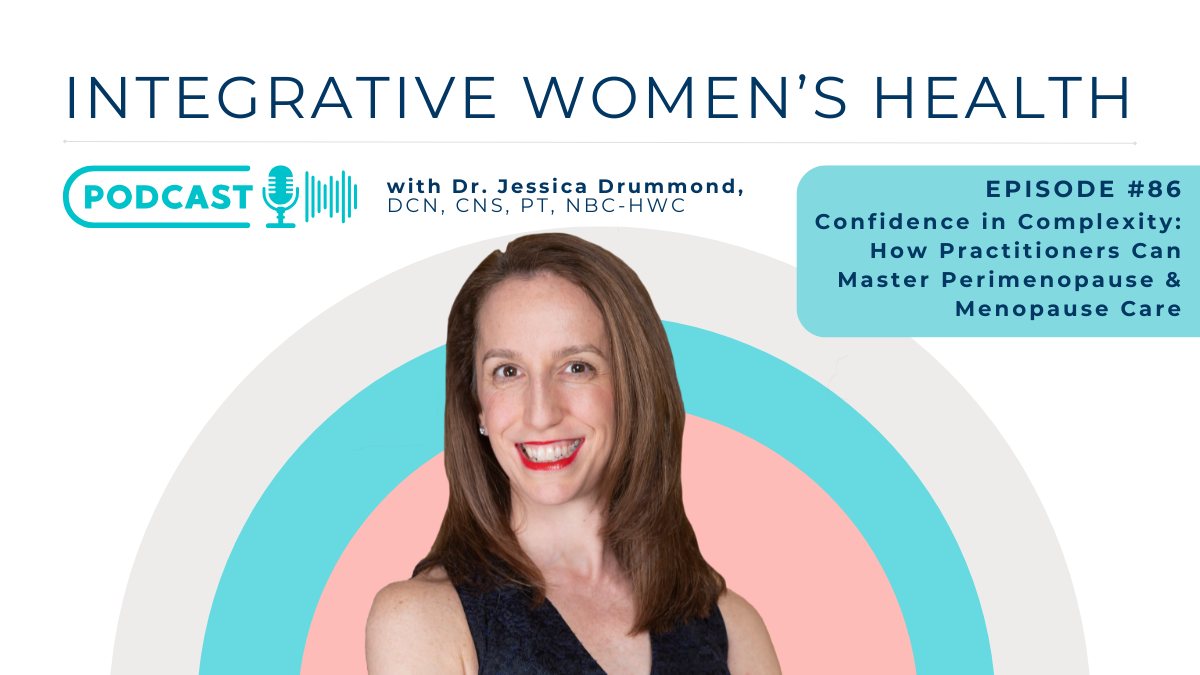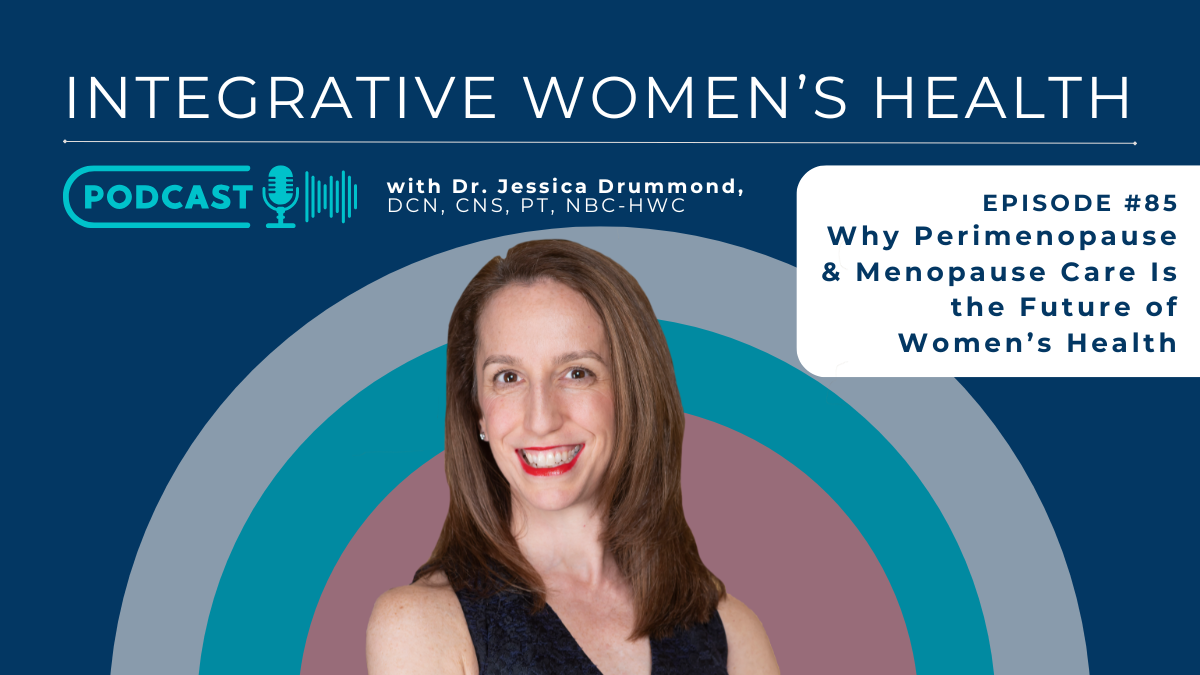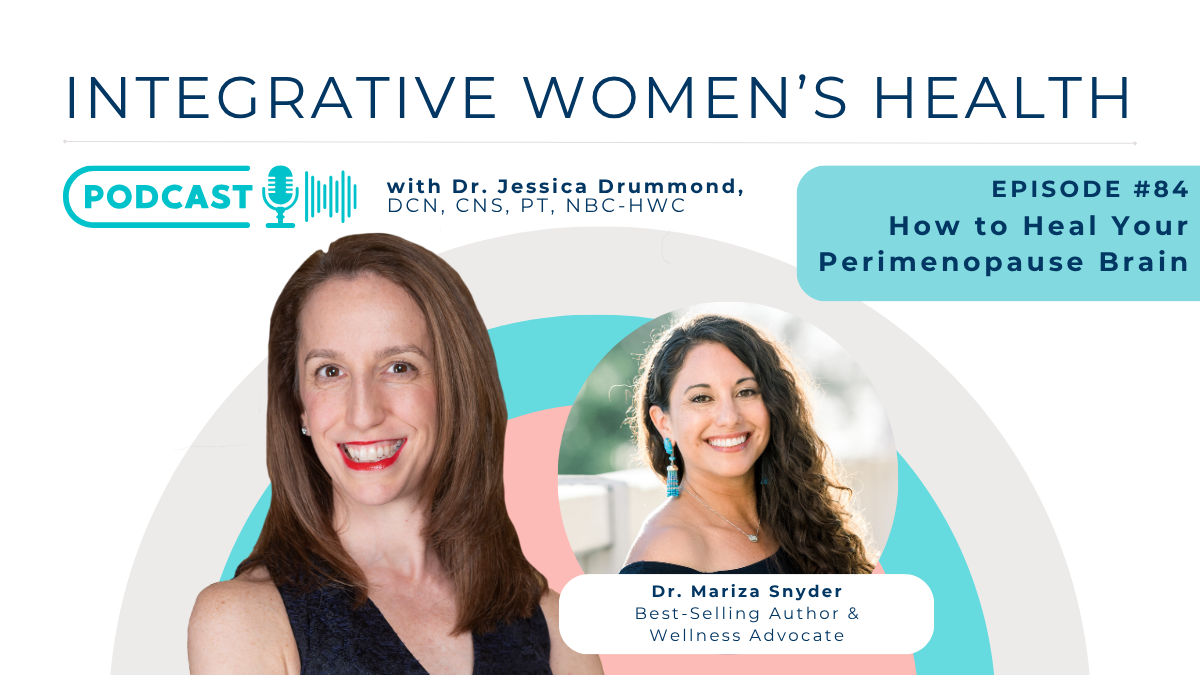Follow Us for Free:
*This episode is sponsored by Osteoboost*
About the episode
“The most important thing for fractures is to prevent them.” – Laura Yecies
Osteoporotic fractures are one of the biggest threats to women’s quality of life as we age, and as practitioners, we’re in the perfect position to help our clients take action before it’s too late. Where cardiovascular disease is the number one killer of women, dementia and hip fractures steal their quality of life. Prevention doesn’t start at 65, it starts in midlife or earlier.
Bone loss can happen silently for years, especially in women with low estrogen, a family history of osteoporosis, or even after a single COVID infection. By the time a client is diagnosed, the window for prevention is already closing. This is why it’s so critical for practitioners to understand all the tools available, from strength training and nutrition to innovative tech that targets bone density and quality.
Today, I’m excited to be joined by Laura Yecies, CEO of Osteoboost, to explore an FDA-approved vibration therapy device designed to strengthen bones and help prevent fractures. We discuss the science behind Osteoboost, its role in a holistic protocol that incorporates nutrition, strength training, and hormone support, and why it’s never too early to start supporting your bone health.
Enjoy the episode, and let’s innovate and integrate together!
About Osteoboost
Osteoboost is a first-of-its-kind FDA-cleared, non-drug treatment for women with osteopenia. Using precision vibration therapy inspired by NASA research, Osteoboost is designed to help prevent bone loss in the spine and hips, the areas most at risk during and after menopause. It’s a proactive, empowering option for women to maintain strength, mobility, and confidence as they move through this next phase of life. Clinical trials show the device reduced spine bone density loss by 85% and hip bone density loss by 55%, offering women a real solution to safeguard their bone health long-term.
Highlights
- Why early screening for bone health is critical and the key risk factors to track
- FDA approval of Osteoboost and what ongoing studies show about its impact
- The inspiration behind Osteoboost and the journey of developing the device
- Understanding bone density changes across the lifespan
- How COVID-19 affects bone health
- Updated screening recommendations and the importance of proactive bone density testing
- What Osteoboost is, how it works, and the technology that powers it
- How to use Osteoboost and stay consistent
- Insights from pivotal clinical trials and what makes Osteoboost effective
- How vibration technology improves bone strength and mimics high-impact exercise
- Why current medications aren’t enough
- Building an ideal osteoporosis prevention plan
- Why planning long-term health must start in midlife
- How Osteoboost supports older adults in their 70s and beyond
- How to access the device, pricing details, and insurance considerations
- Why it’s never too early or too late to take charge of your bone health
- What fractures can predict about future risks and why vigilance matters
- Osteoboost’s FDA approval journey
Connect with Osteoboost
- Osteoboost Website | Osteoboost.com
- Email Osteoboost: support@osteoboost.com
- Osteoboost on Instagram @OsteoboostHealth
Ready to revolutionize your career and grow your practice?
- What is the next step in your career in women’s health and wellness? Start here: https://integrativewomenshealthinstitute.com/start-here/
- Integrative Women’s Health Institute on Instagram | @integrativewomenshealth
- Integrative Women’s Health Institute on YouTube
Learn more about The Integrative Women’s Health Institute’s Programs.
Click here for a full transcript of the episode.
Dr. Jessica Drummond 00:00:03 Hi and welcome to the Integrative Women’s Health Podcast. I’m your host, Doctor Jessica Drummond, and I am so thrilled to have you here. As we dive into today’s episode, as always innovating and integrating in the world of women’s health. And just as a reminder, the content in this podcast episode is no substitute for medical advice, diagnosis, or treatment from your medical or licensed healthcare team. While myself and many of my guests are licensed healthcare professionals, we are not your licensed healthcare professionals, so you want to get advice on your unique circumstances. Diagnostic recommendations treatment recommendations from your home medical team. Enjoy the episode. Let’s innovate and integrate together. Welcome back to the Integrative Women’s Health Podcast. I’m your host, doctor Jessica Drummond. Today I can’t wait to introduce you to Laura Yeezys. She is the CEO of Osteoboost and in this episode sponsored by Osteoboost, I want to share with you a really interesting new way to apply vibration therapy to your clients at high risk for osteoporotic fracture, whether they have osteopenia or osteoporosis, whether they’ve not fractured, whether they have fractured.
Dr. Jessica Drummond 00:01:38 We’re going to talk about how important it is starting in the younger years. You know, I would love to have absolutely everyone have a Dexa scan in their late 20s or early 30s. Let’s build up that bone while we still can. But if not, we certainly want to know this information in midlife for clients in their 40s and 50s. And if they have osteopenia, which having even one Covid infection is a significant risk factor for. But certainly for our clients who have family history of hip fracture or spine fracture, family history of osteoporosis or osteopenia, any low estrogen status, breast cancer or any estrogen suppression states, they are at risk for osteoporosis, and they have done some very good science on this device. It’s one of the very rare orthopedic devices to have been approved by the FDA. And we’re going to get into the nitty gritty of the study, the quality of the study, and the fact that they’re continuing to collect data on people who are utilizing this device, how your clients and yourself can access it.
Dr. Jessica Drummond 00:02:46 So without further ado, let’s dive into the episode and we’ll chat about it on the other side. Welcome back everyone. I’m so thrilled to introduce you today to Laura Yecies. And we’re going to be talking all about osteoporosis, which is really important to all of us around here. It’s one of the most devastating issues that happens for older women, but the work we need to do to prevent and lower the risks of osteoporosis, of course, we have to do earlier in life with our patients and clients mid life for sure, but even earlier when possible. So Laura and her team have developed a really unique tool that I can’t wait to learn more about. She’s the CEO of Osteoboost. And so let’s dive right into the story. And what’s your background and your motivation for developing this device? It’s a tool. It’s a device. Did you have this in mind? Was this a particular problem you were looking to solve? What was the inspiration? Thanks for having me on, Laura.
Laura Yecies 00:04:03 Yes, I’m the CEO of Osteoblast Health.
Laura Yecies 00:04:06 Well, I need to give credit where it’s due to our founder and inventor of physical medicine and pain doctor out of Atlanta, doctor Shane Mangrum. And he specializes in really back pain and was seeing so many women, especially with vertebral compression fractures, which is the most common osteoporotic fracture. There aren’t really great treatments. The most important thing is to prevent them. And so he became intrigued with this problem and how to have a safe early intervention. He saw all the research that was funded by NASA on whole body vibration platforms, which showed promise. But, you know, none of those platforms had the level of efficacy to get through the FDA prescription class two process. But he had the idea of taking that mechanism, which showed promise and putting it in a wearable belt form factor. And what that gives you is better efficacy to the most vulnerable anatomy, the hips and spine. Because the vibration is applied locally, vibration naturally dissipates as it goes from the source. If you’re standing on it, you’re mostly vibrating your feet and ankles.
Laura Yecies 00:05:17 And then as a wearable, it’s much easier to comply on a daily basis. And so that’s sort of the origin and founding. As part of a medical device incubator, Terranova, the research continued. There were some really important NIH grants that got the pivotal trial going. And then during that pivotal trial, it became clear that the company was going to need more resources to take the product forward. And that’s when I was recruited in. So that was September of 2020. Now, my personal background, you know, I spent the first part of my career in tech and then got really interested in health technology. About ten years ago, and I grew up in a family of doctors, both of my parents, two of my siblings. It’s now skipped a generation, two of my children, and my dad was medical director of a nursing home. And so I saw firsthand because I worked there several summers during college. The impact that osteoporosis would have on patients. And pretty much if you’re in that nursing home, it’s Alzheimer’s or hip fracture.
Laura Yecies 00:06:23 And, you know, my grandmother had osteoporosis. So my mother I have osteopenia. So it both appealed to me at a personal level, but really appealed to me or sparked my interest at a public health level where you have this problem that impacts so many people and we’ve really not made dramatic progress, right. It’s very unsatisfying the amount of progress that we’ve made to prevent fractures compared to, you know, the level of technology, innovation and other elements of medicine. So I’m really excited that we can have a big impact and start to change that conversation.
Dr. Jessica Drummond 00:07:02 Yeah. So just to be clear. Osteoporosis is a very, very common issue in women. While it often is not diagnosed until the 60s because that’s when the recommendations are for doing a screening Dexa scan, obviously the bone health challenges, the bone weakness, the bone structural integrity challenges tend to occur younger or start to occur younger because we build most of our bones between puberty and about the early 30s. So at that point, if the person hasn’t built enough bone, then it’s hard to maintain it.
Dr. Jessica Drummond 00:07:39 And I refer everyone on this call back or everyone who’s listening to this podcast, back to our earlier episode with Margie Bissinger. And we talked a lot about the vibration plate strategy, and also just the amount of osteoporosis that older women are really dealing with from a mortality and morbidity standpoint. And you’re exactly right. If you’re working with clients in the perimenopause to menopause transition or even younger postpartum women, perinatal women, this is the time to prevent the two things that women in their 70s, 80s and 90s really struggle with dementia and bone density loss, osteoporosis, osteoporotic fractures. And I want to just bring up another risk factor. I’m also from a family of people with poor bones in a way not generally, but the generation before me, my mother, because the generation before us was not given access to estrogen therapies, so their risk of osteoporosis is even higher. But also as a kid my entire life. Nutrition, heavy strength training. You know, I was a gymnast. So heavy jumping and landing training and all of that I’ve done my entire life.
Dr. Jessica Drummond 00:08:58 And yet, at age 50, I was diagnosed with osteoporosis because of Covid. Covid can infect the bones and cause osteoporosis directly. So I think this is a much bigger problem than we’re even aware of.
Laura Yecies 00:09:15 So you hinted at a topic of knowing your bone density around the time of your peak bone density, right. Your early 30s. An interesting concept because if you have a low peak bone mass and then you lose, I mean, the curve is very predictable. Yet probably the interventions that you do exercise nutrition in the 30s and 40s, 50s potentially could have an even outsized impact. Right? Because you’re more metabolically Active. You have the estrogen on board. So I’m encouraged by the trends. So people always had in mind 65 for the Dexa scan. But the latest U.S. Preventive Services Task Force recommendation really opened the door to menopause. So if your menopause is a risk factor, do screening. It’s a safe test. It’s a relatively inexpensive test. I think we should be thinking about it much more proactively and certainly at the beginning of menopause.
Dr. Jessica Drummond 00:10:16 Absolutely. I think anyone in 40 and over should just at least know their bone density at that point, while they still have their own estrogen, but also going into perimenopause, they can utilize estrogen and these other strategies vibration strength training. So let’s circle back to the device for a minute. We have data on vibration. But let’s talk about this device in particular. Can you describe it for us. Like how do people wear it. How heavy it is. You know can you sit in it? Like, describe it a bit for us.
Laura Yecies 00:10:48 So it’s a precision vibration belt. It looks a little bit like a fanny pack in the sense that there’s a vibration pack. There’s a foam pad on the inside that snug up against your body. And that should go right against the sacrum. So very low on the back. And then there’s a belt, you know, that wraps around. And you need to wear a pretty snugly. In fact, there’s a number of technological features in the belt to make sure that the really precise therapeutic vibration is delivered to the hips and lumbar spine.
Laura Yecies 00:11:21 So there’s a pressure sensor to be sure that there’s adequate pressure from the vibration pack. There’s an accelerometer in the back, and then there’s another accelerometer that goes right over the hip bone, you know, in the front. And so we’re sort of measuring the transmitted vibration through the skeleton and then adjusting dynamically so that you get essentially a A personalized dose. And we know it’s being delivered. And and that’s really I think one of the most important differences between us and vibration platforms is getting that specific type of vibration. We know it is being delivered to the hips and lumbar spine. When you’re standing on something, you’re relying on the vibration waves to transmit all the way up the leg bones. If you’re bending your knee, how you’re standing, you know there’s a lot of variation. And most of those studies show improvements in bone in the distal tibia. So I mean, it’s good to have strong ankles. But what we really need are the hips and spine.
Dr. Jessica Drummond 00:12:21 Yeah, absolutely.
Laura Yecies 00:12:23 Just to answer a couple of your questions, it weighs a couple of pounds.
Laura Yecies 00:12:26 So pretty lightweight. It’s black. It’s kind of sleek looking I mean it looks pretty unobtrusive.
Dr. Jessica Drummond 00:12:32 Do you wear it over underclothes.
Laura Yecies 00:12:34 Over clothing, but like clothing. So Fox yoga pants. Not over parka. Right. And then you asked about sitting. And I wanted to specifically call out that you’re not supposed to be sitting because the body geometry is different. So you need to be standing. You don’t have to be standing still. You could be chopping vegetables. Walking is great. A lot of our patients in the pivotal trial did walking. Walk the dog. You know you can do chores around the house, some gardening, water the plants so you can incorporate into daily lives but not sitting. You need to be upright.
Dr. Jessica Drummond 00:13:09 Okay. Excellent. And how long did your participants wear the device? Each day. How long is it recommended for?
Laura Yecies 00:13:16 So a treatment session is 30 minutes, and we suggest that people wear it as close to daily as possible in the pivotal trial. The average was about four times a week.
Laura Yecies 00:13:27 And then if you wore it three times a week or more, that set of patients, we show that we reduced bone loss by 85%.
Dr. Jessica Drummond 00:13:37 Wow. So let’s talk a little bit more about this study. Tell me more about the pivotal trial.
Laura Yecies 00:13:43 It was a gold standard, randomized controlled trial, 126 women randomized, 63 to active and 63 to a sham or placebo device. Patients did not know it was vibration. They were told it was gentle energy and they were well blinded. It was conducted at University of Nebraska medical center. Postmenopausal women with osteopenia not on any bone active medication. So not on hormone therapy. Not on bone medication. Now, it doesn’t mean that those are contraindications, but for trial design you want to keep as few variables. You want to keep them constant. So we wanted the only difference between the two groups to be active versus sham device. And let’s see. Patients were all given calcium both active and sham. So that was also held as a control targeting 100mg. And to continue their whatever exercise level they had before.
Laura Yecies 00:14:42 We excluded very heavy exercisers. So but the typical things that this population would do was find the average age in the study was 61.
Dr. Jessica Drummond 00:14:52 Excellent. So you do have pretty strong data. Well, blinded, well controlled, but a relatively small sample. Has this trial been reproduced? Are you tracking data of people who are using the device now? Any kind of updates?
Laura Yecies 00:15:08 So actually, for a class two medical device the trial size was quite robust. So this is a pretty typical trial size or if anything large. You know, trials in this type of device are different than drug numbers, which is what I think people tend to compare to. And the most important thing in terms of robustness of the trial is what’s called the p value test of statistical significance. And we were well below that threshold for statistical significance. So, you know, is a very good outcome from that point of view. Now, in terms of other studies, we did a proof of concept study prior to the pivotal trial, where we looked at patients using the device and measured NT, which is a marker of bone resorption before and after.
Laura Yecies 00:15:58 And we saw that using the device induced an acute reduction of NT. So actually it was based on that that we got the grant for the pivotal trial. And then you know, in terms of numbers, of course, as we get out to the real world, we’re seeing another level of numbers. And so patients can opt into sharing their data with us. And hopefully we’ll be able to build your large data sets going forward. We have a grant application into the NIH to do a study in women who are breast cancer survivors. And so we’re really hoping that that gets funded because that’s such an important need. You know, the aromatase inhibitors really do a number on bone density. I mean they’re important drugs. So we want to be able to see if we can combat that.
Dr. Jessica Drummond 00:16:47 Yeah that would be fantastic because there are just such limited options when people either can’t take estrogen or they’re actively suppressing their estrogen for that or any other reason. That would be an excellent option. So in addition to the Dexa, you know, you were talking about looking at bone resorption, you know, in the blood.
Dr. Jessica Drummond 00:17:08 Did you do any of that in the new study or are you collecting any data on that in your current population?
Laura Yecies 00:17:15 We are not collecting that data in our current population, but it’s something that you will certainly look at doing in the future. You know, in the end, those are trend markers. You know, the most important thing is, you know, what happens to the bone. I will say, though, that, you know, we did CT scans in the pivotal trial at baseline and 12 months. And CT scan gives you a real window into other elements of bone quality, which are super interesting. We saw 83% reduction in the loss of bone strength, and that’s essentially a virtual compression test that is even more predictive of fracture risk than a Dexa. Of course, the volumetric bone density, you know, we saw the great results there, but we also saw improvements in cortical bone thickness in the vertebral bodies. You know, in the cortical bone is that shell bone that is so important for fracture prevention and improved bending stiffness.
Laura Yecies 00:18:15 So we’re seeing in addition to the density sort of structural and other quantitative measures of improvement in the bone. And we’re really pleased to see this. And frankly, not that surprised because the mechanism that we’re using is essentially replicating high impact exercise, which we know really improves both bone density and bone quality.
Dr. Jessica Drummond 00:18:37 Well, and I think that’s very important because most of the medications that we currently have for osteoporosis essentially make the bone stronger, but not more flexible, more hard, if you will, harder. And sometimes when that is combined with, you know, a more traumatic fall, those people are actually at higher risk for fracture because the bone is harder, but it’s not more flexible. And that’s I think ultimately what we’re really going for when it comes to long term health, we want the bone to be able to tolerate a fall or an injury, because it’s not so much that having osteoporosis is so problematic. It’s the fracture that is so problematic.
Laura Yecies 00:19:25 Yeah, it’s all about preventing fractures to me, where I see the biggest gap from a medication point of view.
Laura Yecies 00:19:33 You know, I’m not a biochemist to talk about the details of the bone cell level, but we were seeing a presentation from the International Osteoporosis Foundation conference a few weeks ago, and doctor McClung gave one of the keynotes. And essentially, what he was saying is that if you give someone the most powerful regimen, they have bad osteoporosis, you take them with naive bone, starting them on an anabolic medication like affinity, or maybe for tailored stimulus, and then you switch them to an anti restorative. So you’re kind of giving them all guns on average. You get about a half a T score. So that’s you know maybe 1,015%. That’s over ten years.
Dr. Jessica Drummond 00:20:19 Best case scenario.
Laura Yecies 00:20:20 Yeah. Maybe you have a bit more gain in the short term. But then you go back to losing again. It depends on the actual regime. So the bottom line is with the most powerful treatments, there’s still an efficacy gap. You’re not getting people cured. You’re not eliminating fractures. You’re not taking them out necessarily of osteoporosis, particularly if they’re starting below minus three.
Laura Yecies 00:20:44 So how do we think about a condition where, by the way, there’s no new drugs. Late stage clinical trials. So there’s no savior coming over the hill. So then we have to think of what else can we do. And of course it needs to be multimodal nutrition exercise. But we need more tools in the tool belt. And we need to start earlier and prevent some of that loss. And that’s where we see osteoblasts playing a big role. You know hopefully we prevent that need for medication. We delay it or we narrow keep people from getting so far you know below 2.5.
Dr. Jessica Drummond 00:21:22 So in an ideal world let’s say someone has osteopenia and they’re 45 35 or 50 somewhere in the 45 to 60 year old range. What would be your best case scenario of someone utilising the Osteoboost in a multimodal, multimodal program?
Laura Yecies 00:21:41 So ideally they’d use Osteoboost as close to daily as possible for the 30 minutes, optimizing their nutrition. Obviously they would get specific guidance to them from their clinician. But you know, the guidelines are 1200mg of calcium making sure vitamin D level is that goal.
Laura Yecies 00:21:59 Adequate protein. You know, protein is so important for bones as well. And then exercise is important. We don’t see osteoporosis replacing exercise. You really want to be doing both. And you know we have an osteoporosis specific exercise program that we offer as part of our solution. It’s an online self paced program. It’s customized patients. But that’s one option we encourage patients to find, you know, sort of the optimum exercise program for themselves. They may want to be looking at, you know, hormones in consultation with their physicians. They are oftentimes used in osteopenia. But that’s obviously a very personal physician guided decision. But we do know that estrogen is a powerful inhibitor of bone loss. And when we lose estrogen, that’s typical to lose ten, 15% of your bone in the immediate period after that estrogen loss.
Dr. Jessica Drummond 00:22:57 So I absolutely agree with everything you just said. That’s probably the exact program I would have designed. So I love hearing all of that. Now with the Osteoboost device, how long is the client using it? Is this like exercise where she uses it forever or is it one year? Like what’s the long term utilization?
Laura Yecies 00:23:20 So you need to stimulate your bones every day.
Dr. Jessica Drummond 00:23:23 Yeah. Okay. So it’s it’s really forever.
Laura Yecies 00:23:25 Forever.
Dr. Jessica Drummond 00:23:26 Yeah.
Laura Yecies 00:23:26 It’s funny. You know, I love the quote from Kelly Caspersen when she says, patients asked me to, you know, for how long do I use vaginal estrogen? And she says, until three days before you die because it’s twice a week.
Dr. Jessica Drummond 00:23:39 Right. Right. Yeah.
Laura Yecies 00:23:41 So in this case, every day. And I do hope people can use it indefinitely and get that benefit. But let’s take a scenario where someone uses it for five years and let’s say they got the mean benefit, which was, you know, about 2.5% bone strength. So you multiply that by five. And five years later you’re that much better off. And so you may revert to a more rapid bone loss. But you’re ten, 15% better off than you would have been. And you know, there’s no reason to think that there would be any sort of rebound effect, because this is a very natural mechanism, unlike some of the drugs. And it should also be a very persistent effect, unlike medication.
Laura Yecies 00:24:28 But yeah, it’s really, I think, more akin to exercise than a drug. And and actually even in the messaging from doctor McClung that I was talking about from the conference, he was saying, you know, this needs to be viewed as a lifelong chronic condition with intervention, maybe changing different types of intervention, but indefinitely.
Dr. Jessica Drummond 00:24:48 Yeah, I think that’s really a mindset shift. We have to have in general about midlife and older health for women, because up until really recently when people like Kelly Patterson and others and, you know, we’ve been talking about this for 5 or 10 years, like until there’s been more of a conversation around taking care of women long term, like thinking about in your 40s, the kind of function you want to have in your 80s and 90s because, as you said right now, too many women who live to be 80 or 90 are in nursing homes with either fracture or dementia, and the same kinds of things that we do in the 40s, whether it’s estrogen nutrition, strength training, you know, utilizing a device like this, utilizing all of the anti-inflammatories we can for the brain, this kind of strategy, we don’t stop it.
Dr. Jessica Drummond 00:25:45 I mean, we don’t see any reason to suddenly start eating McDonald’s in the 70s or laying down and not exercising again, like keep going. So I think that mindset shift is really important.
Laura Yecies 00:26:00 And I think as jobs can be even more useful when people are older, right? Let’s say they’ve preserved their bone but have osteopenia in their 70s. Maybe they have joint issues. It’s a little harder for them to do the high impact exercise. So they do what they can do, the weight lifting that they can, the weight bearing extras that they can, but then really add in the Osteoboost to make sure you’re getting adequate stimulation to the spine and hips.
Dr. Jessica Drummond 00:26:25 I could see that. So for women maybe 70 or older, it sounds like there’s no age that’s too late to begin.
Laura Yecies 00:26:34 No, we had patients, you know, into the 70s in the pivotal trial, even though the average was 61. People will often say, you know, is it like an aggressive vibration? And I assure them it’s not.
Laura Yecies 00:26:46 It’s very comfortable. It feels good. It feels like a massage. It’s pretty quiet. You can be on the phone. The person on the other end of the phone wouldn’t know.
Dr. Jessica Drummond 00:26:55 That’s wonderful. I mean, really, it’s definitely something that would be very reasonable to add 30 minutes a day. You could have a standing desk and just be on one meeting where it, you know, like you said, I probably I certainly chop vegetables for 30 minutes a day in my house. I really think that’s very user friendly. So how can people access this? And since we do know that this is a massive problem for a huge percentage of women in their 50s and older. My goal, along with I’m sure yours would be to like everyone should have one of these. How do we get that? What are you guys doing to make that happen?
Laura Yecies 00:27:34 We really try to have a very patient, friendly, consumer friendly process. It is a prescription device, but the patients can go on our website and order.
Laura Yecies 00:27:44 So you go into osteoblast com and you’ll see it by now. And you go through the process to order at the end of that process. We basically say, would you like to get a prescription from your personal physician? And that’s a great option because they have your Dexa data. They can be tracking you over time. But we also have a telehealth option just for convenience purposes. It’s $30 and you answer a few questions online. And those prescriptions go to our online pharmacy health warehouse. So doctors can prescribe via their electronic medical record. Fax. They can even call the pharmacy. The old fashioned way, you know. And then we ship the device to patients. It’s $995. You can use FSA and HSA. We are working on insurance reimbursement. We don’t have that quite yet, unfortunately. It typically takes longer for devices than for drugs. But we did try to make it so it would be possible for hopefully many people to get started right away with their bone health. That includes the device, of course, the warranty support, and then one year of the exercise program, which is really geared towards fall prevention and balance.
Laura Yecies 00:28:58 And obviously to prevent fractures, you keep good bone quality, bone strength and then not to fall. So that’s important too. There’s a companion app which has the calcium tracker and some educational components as well.
Dr. Jessica Drummond 00:29:13 And do you have any kind of payment plan. In?
Laura Yecies 00:29:16 Not yet, but we will have one in place soon.
Dr. Jessica Drummond 00:29:20 Okay. That’s great. We don’t have, as you were mentioning. Much good advancement in medical options for osteoporosis. So I think knowing the data on vibration, knowing that this is much more directly targeted, knowing that we have the evidence to support it, that it’s FDA approved for safety and efficacy. I really think this is a valuable addition to exactly the protocol that you shared, and I would really encourage all of the professionals in our community to take a look at this. I think, you know, physical therapists, occupational therapists could be among the best. And we have a lot in our community, you know, of really encouraging this to be utilized in addition to primary care physical therapists.
Laura Yecies 00:30:08 They really understand, I mean, their whole mission life is using things like exercise to promote health. And while this isn’t exactly exercise, we’re targeting that mechanism. And so we do see a lot of physical therapists recommending us. One way I think about this is I like to think of analogies. And in the cardiovascular world, you know, we’re checking people’s blood pressure and cholesterol early. And we have, fortunately, some interventions, you know, like the statins and blood pressure medicines that it’s not that they don’t have side effects. They do. But overall they’re really safe. And so people are starting on those treatments in their 40s to prevent the heart attack in their 70s. And we haven’t had anything like that in the bone health world. And that’s exactly what osteoblasts can be doing. Where you have a safe intervention, you can start early, hopefully prevent or dramatically slow bone loss. For some people, they’re able to gain bone and then hopefully we can prevent those later fractures.
Dr. Jessica Drummond 00:31:09 Yeah absolutely. Part of the nursing home prevention protocol.
Laura Yecies 00:31:13 You know. And if you think about quality of life in that decade, the 80s or the 70s, so much of it is your musculoskeletal system. What do I want to be doing then? I want to stay active and be playing with grandkids. Great grandkids. Right. And so I don’t want to fracture.
Dr. Jessica Drummond 00:31:30 Yeah. My mom has osteoporosis and she has been through a number of treatments. She had her first fracture at work when she was probably in her early 70s. She tripped over a laundry basket. She was working in a preschool, and it was an elbow fracture. That was a pretty severe one. And then she had her second fracture. Five years ago now, something in that range. She was walking my brother’s dog and tripped over it and had a femur fracture. Really severe. But thankfully she had been because it was kind of the early pandemic. She had been walking like ten miles a day, and so she was in very good physical Shape. Still, though, it took her about two years to recover and none of the medications have really been helpful, and many of them have had pretty severe side effects for her.
Dr. Jessica Drummond 00:32:24 So, you know, I think that this is the kind of person, you know, it’s rare. I mean, not that it’s rare. It’s high risk in your 70s and 80s not to recover from such a severe fracture. And so I think when we start talking about, you know, about 30% of women die, another 30% basically really struggle with function for the rest of their lives. So my mom’s preparation of physical strength training and walking is the only reason she was able to fully recover. But even then it took about 2 to 3 years. So I think we really need to be talking to our clients in their 40s and 50s and 60s, or however old they are, but certainly 40 and up. Never too late.
Laura Yecies 00:33:11 Never too early, but never too late.
Dr. Jessica Drummond 00:33:13 Never too early and never too late. So even if you have a client who had one fracture, you know, sometimes we’re kind of debating the question of was it a traumatic fracture? Was it more structural? And to me it doesn’t matter.
Dr. Jessica Drummond 00:33:25 Like let’s get them stronger either way. I have a client who was 30 when she had her first fracture because she had celiac disease that was undiagnosed, so she wasn’t absorbing a lot of her nutrients. So I really think our students and our community, as health and wellness professionals for women, are in the perfect spot to start talking about these resources, because whether your client is 75 and had her second fracture or her first fracture and was able to recover, now we need to be even stronger because one fracture is predictive of the next.
Laura Yecies 00:34:02 Yeah, there’s even some data that says even non fragility or traumatic fractures are also still predictive.
Dr. Jessica Drummond 00:34:10 Yeah.
Laura Yecies 00:34:11 There was a article a couple of years ago on that. So yeah. If someone is fracturing we really want to pay attention.
Dr. Jessica Drummond 00:34:18 Yeah absolutely. Well I’m thrilled that this device is on the market. I’m thrilled that you have such strong evidence behind it. And you were able to get through the FTA hoops and.
Laura Yecies 00:34:30 They were high, high hoops, right? We were de novo clearance.
Laura Yecies 00:34:34 Yeah. There’s only been I think 14 orthopedic de novos ever very few startups. So it was a high bar. And we’re really proud of the evidence that allowed us to get through that process.
Dr. Jessica Drummond 00:34:47 Well, thank you so much for coming and sharing that with us today. I’m really excited about this device for myself and my family and definitely my patients, because so many of them are in that risk factor bucket. And the sooner we can get them strong, the better.
Laura Yecies 00:35:05 Thank you for the opportunity to share what we’re doing.
Dr. Jessica Drummond 00:35:08 Thank you so much for being here. Thank you for sharing. And how can people come and find more?
Laura Yecies 00:35:14 Osteoboost one word O-S-T-E-O-B-O-O-S-T. You can find sort of information on the science on how to use the product. Getting started our pivotal trial manuscript. So yeah, we’d love to have you come check that out. Any questions: support@osteoboost.com. We’re here to help.
Dr. Jessica Drummond 00:35:35 Thank you so much, Laura. Thanks again to Laura Yeezys for joining me today. I’m actually extremely encouraged by this device.
Dr. Jessica Drummond 00:35:49 I think vibration therapy that’s a wearable that, you know, it’s just 30 minutes a day in combination with that entire protocol of optimal minerals, optimal vitamin D, optimal Nutrition, strength training, jumping balance training, landing training and doing it all early rather than waiting until your client has a fracture but doing it preventative and look doing it in recovery. So if you’re a health coach, physical or occupational therapist, physician, gynecologist, nurse midwife, if you work with women, the women you are working with, their two biggest risk factors for quality of life over 70 are dementia and osteoporotic fracture. Certainly, cardiovascular disease is the number one killer of women, but dementia and hip fracture and spine fracture steel quality of life from women, sometimes for that entire last decade. This is not what I want I on my nursing home prevention plan. So I was really grateful to have osteoblasts come and speak with us. They are the sponsor of this episode. Go check it out and have your clients who may be at risk for osteoporosis or know they have it.
Dr. Jessica Drummond 00:37:22 Explore this really valuable tool. Thanks so much. I’ll see you next week. Thank you so much for joining me today for this episode of the Integrative Women’s Health Podcast. Please share this episode with a colleague and if you loved it, hit that subscribe or follow button on your favorite podcast streaming service so that we can do even more to make this podcast better for you and your clients. Let’s innovate and integrate in the world of women’s health.
Join Dr. Jessica Drummond to learn the three key steps to becoming a successful, board-certified Women’s Health Coach who leaves a lasting positive impact on their clients.
Learn how utilizing health coaching skills in your practice is crucial to your success, leaving a lasting impact on your clients, and shifting the paradigm of women’s healthcare.

Dr. Jessica Drummond
Founder & CEO
The Integrative Women’s Health Institute
At the Integrative Women’s Health Institute, we’ve dedicated 17 years to crafting evidence-driven, cutting-edge programs that empower practitioners like you to address the complexities of women’s health.
Dr. Jessica Drummond’s unique approach focuses on functional nutrition, lifestyle medicine, movement therapies, nervous system dysregulation, trauma, and mindset – essential elements often overlooked in traditional health education.
In addition, your training will be fully evidence based, personalized, and nuanced (this is not a cookie cutter approach) in functional nutrition, exercise, recovery, cellular health, and all other lifestyle medicine tools.
You’ll learn to support your clients with cutting edge tools safely and effectively.

